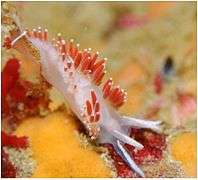Flabellina verrucosa
| Flabellina verrucosa | |
|---|---|
 | |
| Coryphella verrucosa from Gulen Dive Resort, Norway. | |
| Scientific classification | |
| Kingdom: | Animalia |
| Phylum: | Mollusca |
| Class: | Gastropoda |
| (unranked): | clade Heterobranchia clade Euthyneura |
| Superfamily: | Flabellinoidea |
| Family: | Flabellinidae |
| Genus: | Flabellina |
| Species: | F. verrucosa |
| Binomial name | |
| Flabellina verrucosa (M. Sars, 1829)[1] | |
| Synonyms[2] | |
| |
Flabellina verrucosa, is a species of sea slug, an aeolid nudibranch, a marine gastropod mollusc in the family Flabellinidae.[2] It is found on either side of the northern part of the Atlantic Ocean.
Distribution
Current thinking is that it is widespread in the North Atlantic Ocean and has also been found in the North Pacific Ocean.[3] In North America, its range includes the Gulf of St Lawrence and the Gulf of Maine.[2] Animals from British Columbia and Alaska are also identified as this species but differ significantly in colour pattern and are probably a sibling species, described as Coryphella longicaudata.[4]
Description
The original description of this species is of an animal with unusually short, rounded cerata, hence the name verrucosa.[5] The name has been extensively used for animals of different appearance, with long cerata, including Flabellina rufibranchialis, the type species of the genus Coryphella.
The body of Flabellina verrucosa is translucent white. The tail is elongated and pointed with a mid-dorsal line of opaque white pigment in which there are round translucent spots. This white line may extend along the back amongst the cerata from the tail, breaking up into spots. In different parts of its range this species has differently coloured forms, which may be different species. In some places the digestive gland in the cerata is red while in other locations, cerata with brown digestive gland predominate, though it is known that the colour of the digestive gland in Flabellina species is dependent on diet.[6] There is also considerable variation in the colouring of the tips of the cerata, from narrow broken rings (F. rufibranchialis form) through broad white bands to white almost covering the tips of the cerata in the typical form. The oral tentacles have a broad white stripe on the upper surfaces.
The maximum recorded body length is 35 mm[7] or up to 40 mm (1.6 in).
This nudibranch is similar in appearance to Flabellina gracilis and many other Flabellina species.[6]
 Gulen Dive Resort, Norway
Gulen Dive Resort, Norway Gulen Dive Resort, Norway
Gulen Dive Resort, Norway British Columbia form (Flabellina longicaudata O'Donoghue, 1922)
British Columbia form (Flabellina longicaudata O'Donoghue, 1922) Kenai Fjords national Park, Alaska (Flabellina longicaudata O'Donoghue, 1922)
Kenai Fjords national Park, Alaska (Flabellina longicaudata O'Donoghue, 1922)
Ecology
This species was described from Norway where it is a common species in depths of 2–10 metres (6 ft 7 in–32 ft 10 in).[1] Minimum recorded depth is 0 m.[7] Maximum recorded depth is 183 m.[7] Flabellina verrucosa sensu lato has been reported at depths down to about 300 metres (980 ft) and seems to inhabit both sandy and rocky habitats.[3]
Flabellina verrucosa grazes on sessile invertebrates on the sea bed. It also feeds on detritus and plankton. In the United Kingdom, it lives almost exclusively on the oaten pipes hydroid (Tubularia indivisa) whilst the juveniles have a wider diet range.[8]
Flabellina verrucosa is a hermaphrodite but self-fertilisation does not occur. Two adults engage in an elaborate touching ritual that was at first thought to be agonistic behaviour. The tentacles touch each other and are then withdrawn repeatedly and there is biting, lunging and sidling. The actual act of copulation is very quick.[9] The eggs are laid in a gelatinous string neatly coiled in a spiral on the seabed.[8] After hatching, the veliger larvae drift as part of the plankton, eventually settling on the seabed.[9]
Flabellina verrucosa has the ability to incorporate nematocysts from its prey into the tissue of its cerata as a defence.[10] It was found experimentally that when the nudibranch was kept in the vicinity of certain predators such as the common sunstar (Crossaster papposus), the bergall (Tautogolabrus adspersus) (a fish) and the shore crab Carcinus maenas, it incorporated more nematocysts than it did in a predator-free environment.[10]
References
- 1 2 Sars M. (1829). Bidrag til soedyrene naturhistorie, Pt. 1: pp. 1-59, pls. 1-6. Bergen.
- 1 2 3 Gofas, S. (2015). Flabellina verrucosa. In: MolluscaBase (2015). Accessed through: World Register of Marine Species on 2016-01-26.
- 1 2 Telnes, K. (2012) Nudibranch - Flabellina verrucosa. Seawater Norway, Retrieved July 04, 2012
- ↑ O'Donoghue, C. H., (1922). Nudibranchiate Mollusca from the Vancouver Island region. III. Records of species and distribution. Transactions of the Royal Canadian Institute 14(1):145-167, pls. 5-6.
- ↑ Rudman, W.B., 2003 (Apr 30). Comment on Re: Flabellina? from Norway by Jussi Evertsen. [Message in] Sea Slug Forum. Australian Museum, Sydney.
- 1 2 Rudman, W.B., 1999 (August 27) Flabellina verrucosa (M. Sars, 1829). [In] Sea Slug Forum. Australian Museum, Sydney.
- 1 2 3 Welch J. J. (2010). "The “Island Rule” and Deep-Sea Gastropods: Re-Examining the Evidence". PLoS ONE 5(1): e8776. doi:10.1371/journal.pone.0008776.
- 1 2 Picton, B.E. & Morrow, C.C. (2015). Coryphella rufibranchialis (Johnston, 1832). [In] Encyclopedia of Marine Life of Britain and Ireland. Accessed on 2016-1-26
- 1 2 Carefoot, Tom. "Reproduction: Mate selection and copulation". A snail's odyssey: Nudibranchs and relatives. Retrieved 2012-12-24.
- 1 2 Frick, K. (2003). "Response in nematocyst uptake by the nudibranch Flabellina verrucosa to the presence of various predators in the Southern Gulf of Maine". Biological Bulletin. 205 (3): 367–376. PMID 14672990. doi:10.2307/1543299.
External links
| Wikimedia Commons has media related to Flabellina verrucosa. |